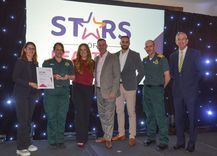Innovative technology helps keep frail patients out of hospital
Date: 8 October 2025The East of England Ambulance Service’s advanced practice (urgent care) team is pioneering the use of portable medical technology previously reserved for critically ill patients to support elderly and end-of-life care patients in their own home.

The team has implemented a new, safe and effective method of assessing patients’ bladder and urinary condition using point of care ultrasound (POCUS).
Since its launch earlier this year, hundreds of patients have benefited from the addition of POCUS bladder scanning to the urgent care team’s toolkit. It has quickly become a vital tool for clinical assessment and decision-making, especially for patients who struggle to communicate abdominal symptoms.
Using the hand-held Butterfly ultrasound tool, paramedics can scan patients and interpret results using supporting software on their iPads, enabling faster, more accurate diagnoses.
In one recent case, the team visited an elderly patient living in a remote area who had been referred to hospital. Thanks to bladder scanning paramedics were able to place a urinary catheter at home, avoiding a long and uncomfortable journey to hospital.
Tim Hickey, clinical lead for urgent care for EEAST said:
“Previously, this patient would have faced a one-hour journey to hospital, followed by admission, scanning, and catheter placement—likely involving an overnight stay.
We were able to do all of this in the patient’s home, significantly improving their experience.”
While the POCUS technology has been used for some time by critical care paramedics and trauma doctors on air ambulances, this is thought to be the first-time paramedics in England are using it on patients that are not critically ill.
Other ambulance trusts are now exploring EEAST’s approach, and the team is investigating further uses for the technology, including lung scanning and accurate placement of anaesthetic injections.
The Advanced Practice (Urgent Care) Team was recently recognised for their work, winning the Excellence in Innovation Award at the Stars of EEAST Awards held in Cambridge.
Notes:
The Butterfly iQ3 hand ultrasound scanner used by EEAST uses advanced AI assisted Auto Bladder Volume, which goes beyond the simple 2-D estimations of traditional scanners.
This technology automatically calculates and provides a 3-D visualization of the bladder volume in seconds, speeding up Post-Void Residual (PVR) measurements.
This technology allows the user to calculate bladder volume, speeding up Post-Void Residual (PVR) measurements. This ensures greater accuracy and reduces user variability, allowing advanced care practitioner teams to confidently perform rapid, non-invasive assessments and minimise unnecessary catheterisations.
